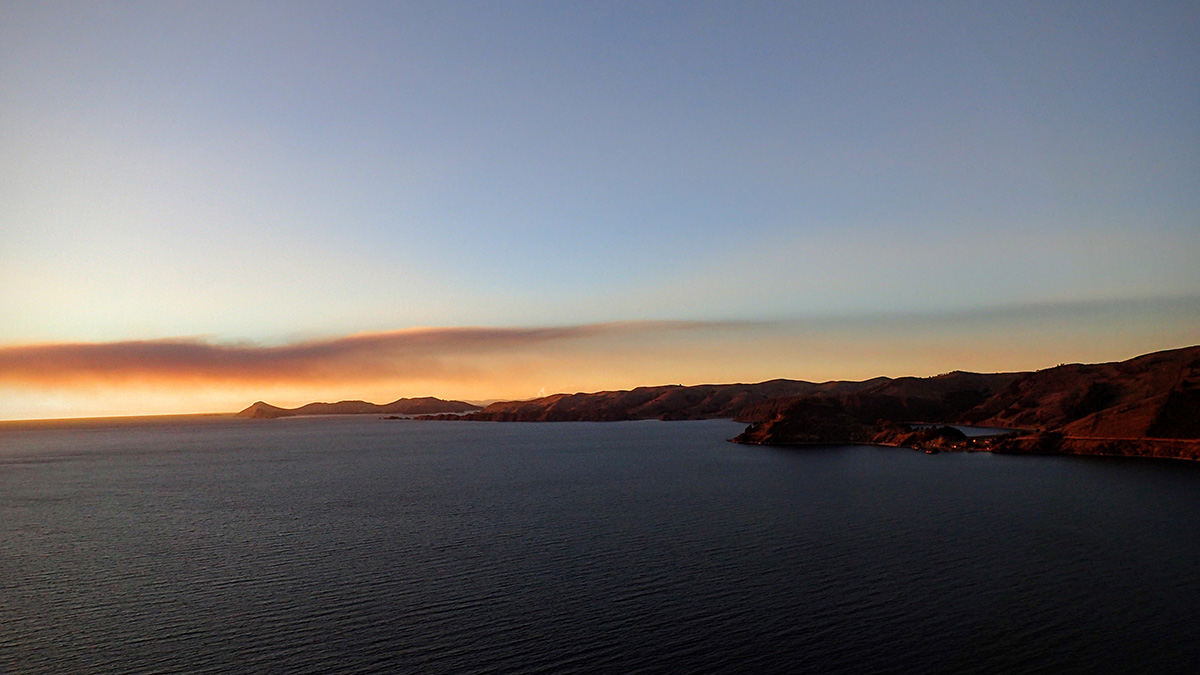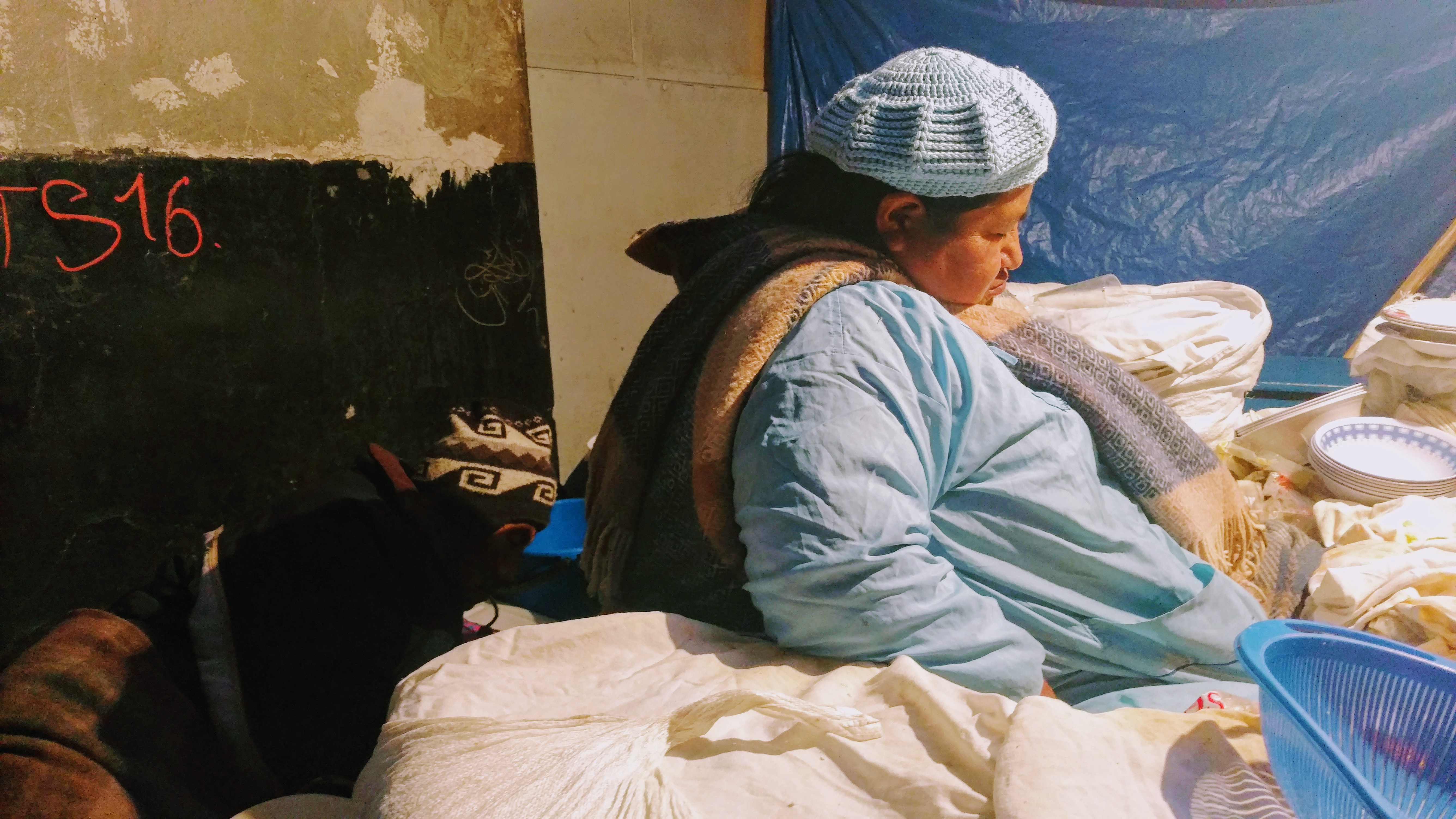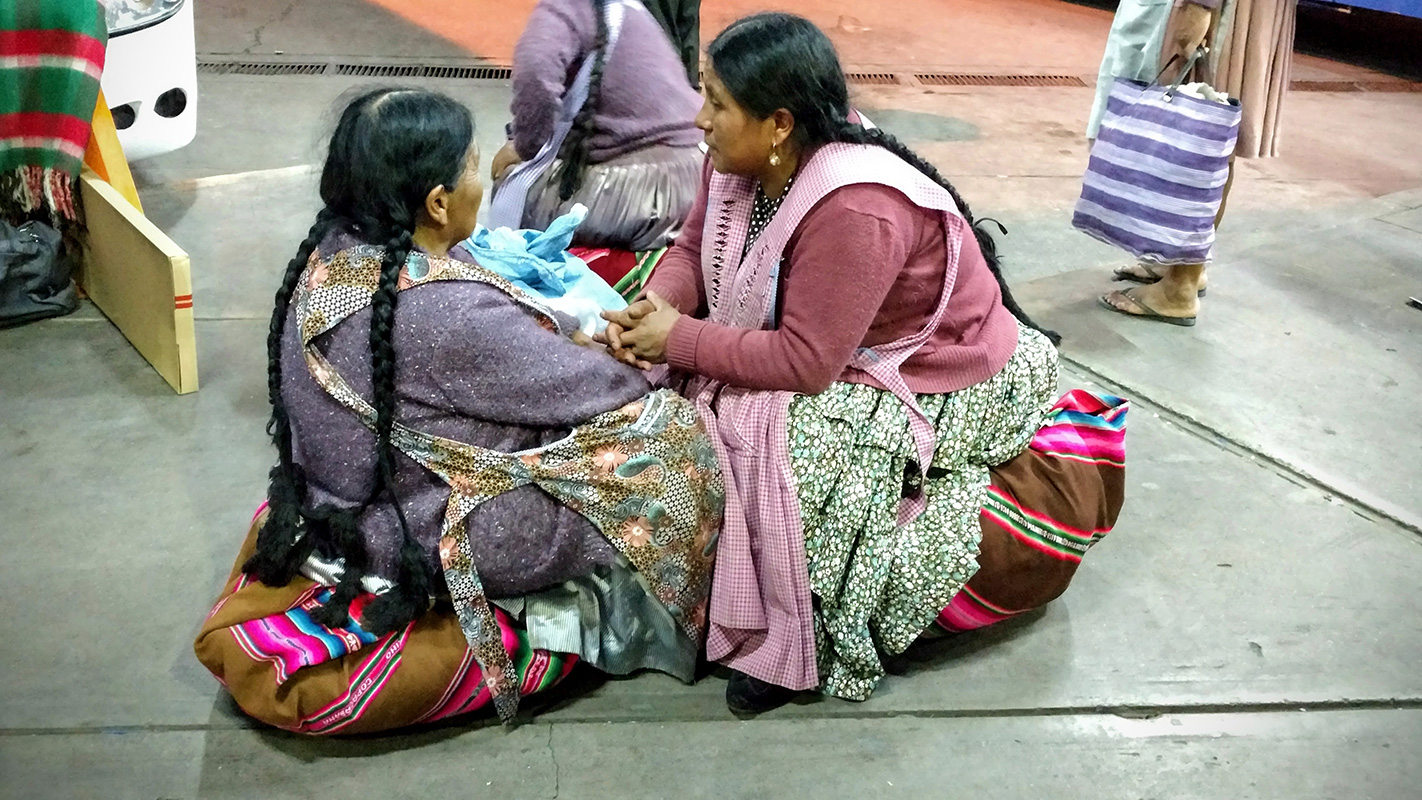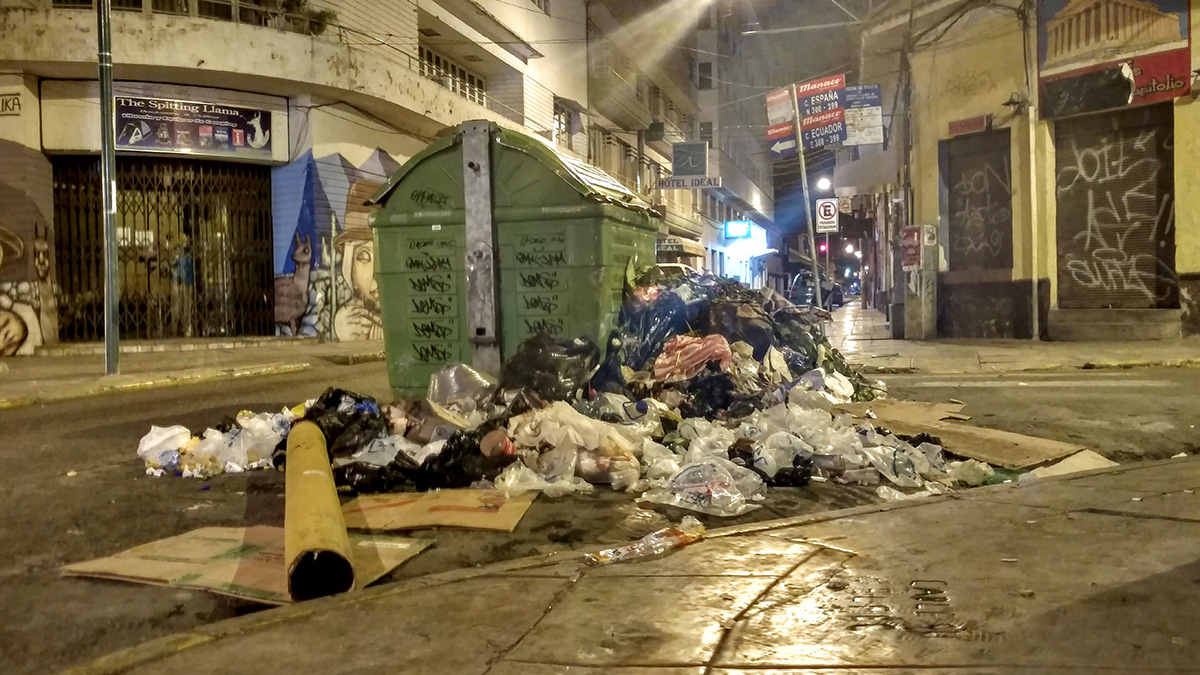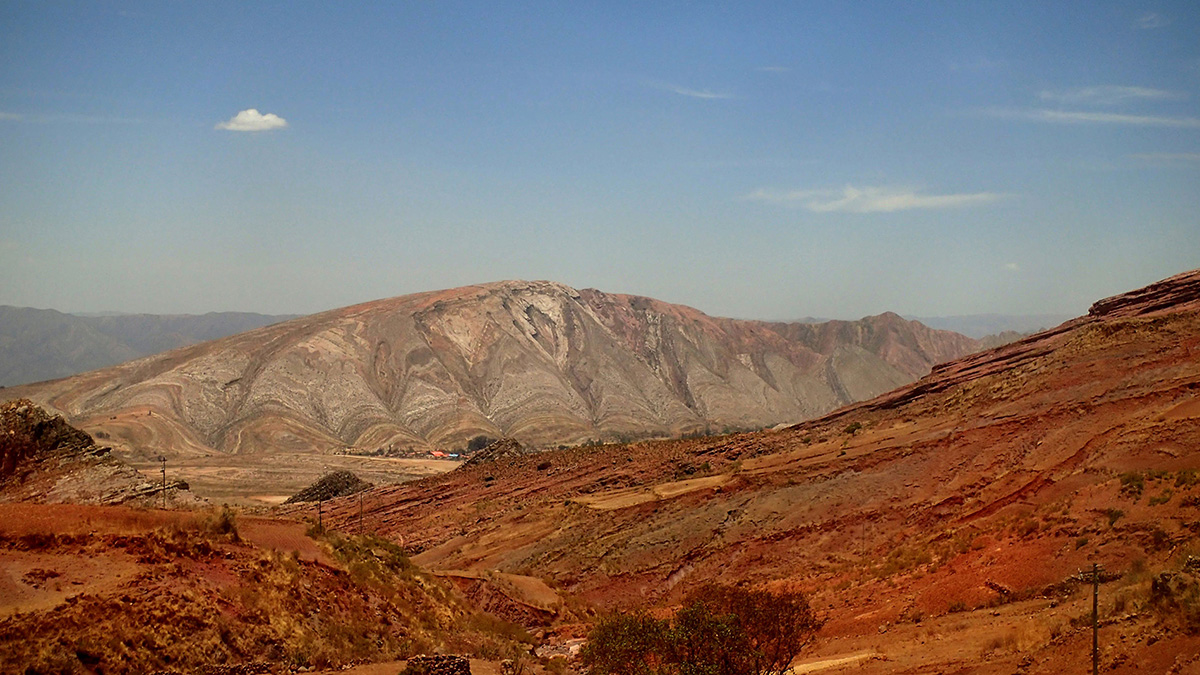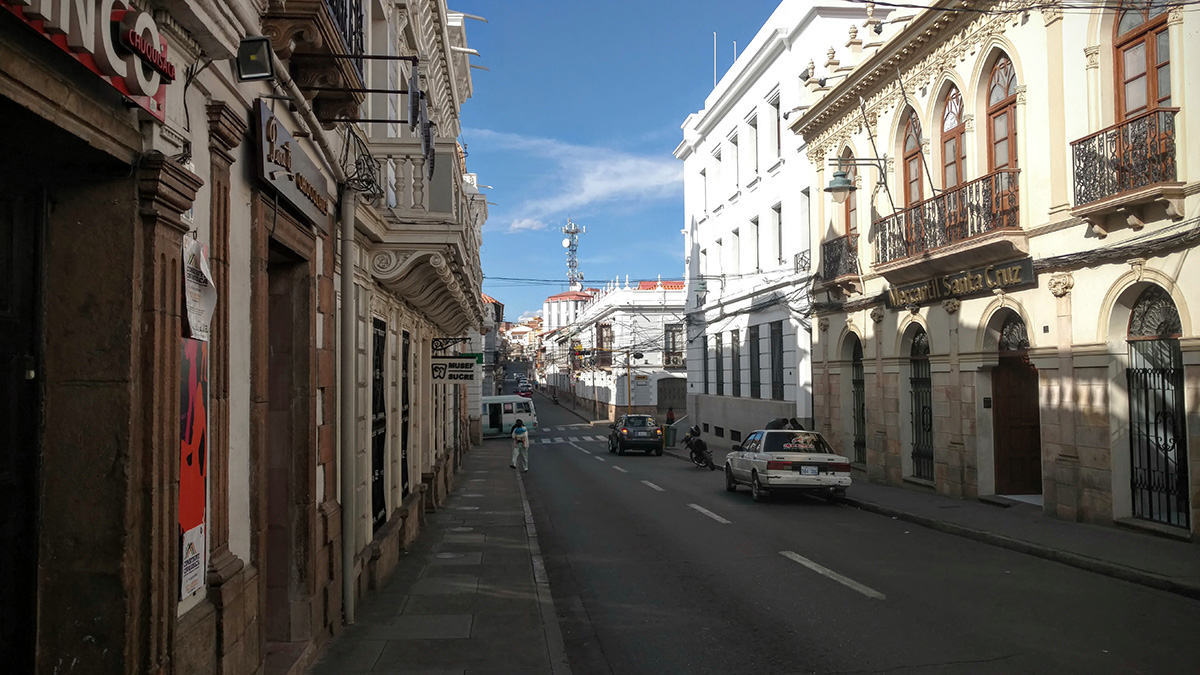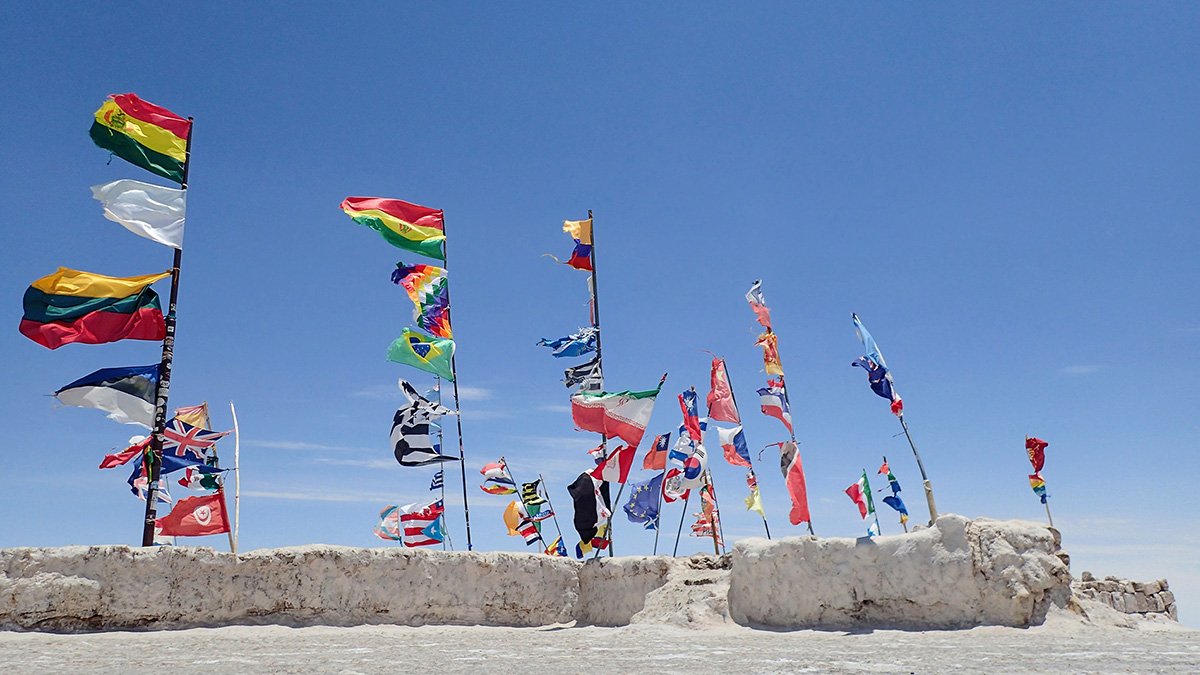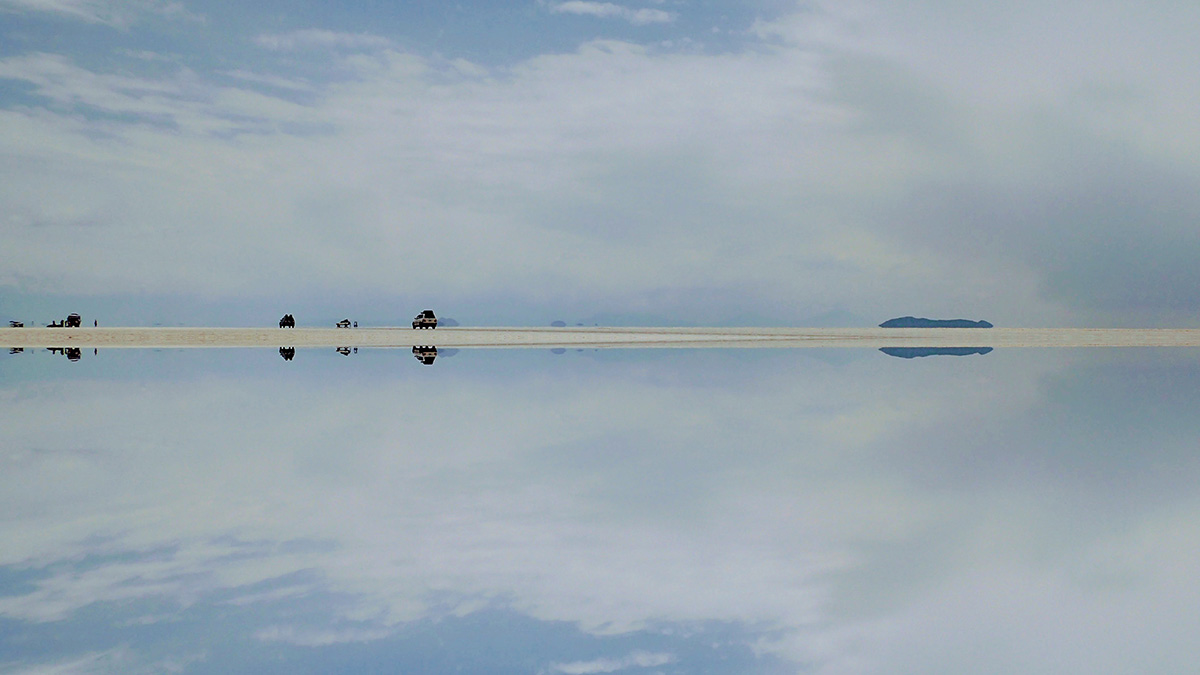If you’ve ever wanted to see the old South America, the South America in 80s hollywood movies, the South America from the classic photos we’ve all seen, the chicken bus South America, then Bolivia is your best bet. For the record, chicken buses even here are on their way out, but some of the rest is easy to find here. The colorful clothing, the out of place hats, the makeshift sidewalk eateries, you’ll find more here than anywhere else in South America. Bolivia is running at its own pace, whether by design or not. More traditional than most of its neighbors, less capable of change, and possibly less interested, you’ll get a true sense of what life was like a century ago while roaming through the variety of landscapes and towns that this country has to offer. Landlocked, impoverished, a new democracy and seen as the continent’s little brother, Bolivia is a hidden jewel that is hard to polish but worth the effort. I managed to spend 2 months here and could have spent a good deal more but other plans got in the way. No matter, I had 2 pretty amazing months and got a pretty good feel for what much of South America must have looked and felt like before the latest wave of progressive development that has so quickly transformed a large swath of the continent; and it was intriguing if not at times depressing.
BOLIVIA : GENERAL FACTS
| Population | 10,969,649 (July 2016 est.) |
| Capital | La Paz (administrative capital); Sucre (constitutional [legislative and judicial] capital) |
| Languages | Spanish (official) 60.7%, Quechua (official) 21.2%, Aymara (official) 14.6%, foreign languages 2.4%, Guarani (official) 0.6%, other native languages 0.4%, none 0.1% note: Bolivia’s 2009 constitution designates Spanish and all indigenous languages as official; 36 indigenous languages are specified, including some that are extinct (2001 est.) |
| GDP | $74.58 billion (2015 est.) |
| GDP Per Capita | $7,000 (2015 est.) |
| Agricultural Products | soybeans, quinoa, Brazil nuts, sugarcane, coffee, corn, rice, potatoes, chia, coca |
| Industries | mining, smelting, petroleum, food and beverages, tobacco, handicrafts, clothing, jewelry |
| Labor force |
agriculture: 32%
industry: 20%
services: 47.9% (2009 est.)
|
| Population below poverty |
45% (2011 est.)
|
I always thought of Bolivia as verdant, lush, half rain-forest and half Andean forests. I was wrong. The truth is, it’s more like half mountainous desert and quasi-desert and not quite half Amazon. Like its neighbors to the Northeast and Northwest it has serious issues with deforestation, though the causes seem to be less industrial in nature and one more of poverty and a lack of resources. Bolivia is essentially all on a massive plateau right in the middle of the continent, straddling the Andes in the west and dropping down to the Amazon Basin in the east and Northeast. The temperatures vary wildly for such a small country, due to this. Within a day you can go from the dizzying heights of 5km up to a few hundred meters in altitude, and from temperatures that make your teeth rattle to the blistering heat and humidity of almost untouched jungle. But Bolivia is rife with problems, including corruption, lack of resources such as water, and pollution. In fact, I’ve never experienced worse air quality than I have in many of Bolivia’s cities and towns. The exhaust from cars here is uniquely suffocating and toxic, helping to kindly provide me with a sore throat that lasted weeks. Not even New Delhi could compete, but the pollution issue is more than just affecting the air, it’s everywhere and particularly on the sides of the roads as tons and tons of plastic unofficially replace bushes as signposts here. The country is buried under plastic bags and bottles. But the pros? Well, for travelers it’s dirt cheap, there’s tons to see if you like varied climates, mountains, deserts, jungle, hiking and biking. Bolivia has all of that on offer and at half the price of any of its neighbors. It’s the nomad on a shoestring’s paradise.
Center-East Bolivia
Copacabana
Copacabana is a small town on the shores of Lake Titicaca and one of Bolivia’s biggest tourist attractions. Honestly, I couldn’t tell you why. Copacabana is nothing special, but the allure of Lake Titicaca, the largest lake in South America, the highest “commercially navigable lake” and the home of the floating islands of the Uru people seems to be an intriguing prospect for most, myself included. That being said, it’s quite disappointing in my opinion, though I didn’t visit the supposed highlight of the area (Isla del Sol) which is apparently quite beautiful. But the lake itself, is just a lake like many others, quite polluted as was made obvious by visiting Puno and seeing the amount of scum on the edges of the city. Copacabana itself is a bit of a tourist trap. By Bolivian standards it’s a bit expensive and full of restaurants catering to tourist palates but without any of the refinery. The food here is generally awful and that includes much of the street-food. Here you begin to get a sense for how much Bolivians love entrails, stomach and other less conventional foods. It’s not a compliment. I’m open to most types of food, but the smell of grilled stomach lining is not something most people would appreciate and the taste is no better. Those are just my personal tastes, but Bolivians seem to have a particular affinity for these.
Copacabana itself has little to offer in terms of entertainment. It’s brutally cold, sometimes even during the day, and often windy. It has a number of bars but nothing that is guaranteed to be a good time or to be reliably packed. Most travelers only spend a couple days here to see the lake for themselves and to visit Isla del Sol, which as mentioned, is the highlight. Copacabana also acts as a common gateway between Peru and Bolivia, the logic being, if you have to cross the border, why not do it along the famous Titicaca.
COPACABANA
La Paz (Administrative capital and 3rd largest city in Bolivia, pop: 757,184 (2012 est.))
Driving into La Paz from Copacabana was, let’s say, a bit shocking. I had and generally do almost no research before choosing my next destination, and therefore, as per usual, knew almost nothing about La Paz. I also didn’t know that the route I was on would take me through El Alto, the conjoined twin city of La Paz. See La Paz is essentially in a bowl surrounded by a sort of plateau on 3 sides and mountains out in the distance on the last remaining side. The plateau however, is home to El Alto. I’m rarely intimidated by new places, but El Alto felt sketchy. It may have been the numerous and I mean numerous spray painted messages on people’s walls saying “all criminals and thieves caught will be burned alive, neighborhood watch in effect” or it could have been the complete and utter lack of infrastructure, or the lifeless faces and walls of the city, but my impression was not good and as far as I knew, this was La Paz. Well, it turns out it wasn’t. At the edge of El Alto, and where by this time it began feeling less sketch, is the end of the plateau where the bottom drops out and the view on La Paz makes itself visible. I breathed a sigh of relief. This was a real city. La Paz itself may only be 700k in population officially, but the real number is much higher and if you take the GMA, the number balloons to somewhere between 2 and 4 million. La Paz itself is a disaster. Messy, chaotic, dirty. It’s great! I headed straight to Loki Hostel, which while amazing, quickly became a trap. I didn’t explore the city nearly as much as I should or could have for reasons of pure comfort and fatigue. Loki was a haven and a sanctuary for this tired traveler. But the times I did venture out, La Paz certainly treated me to interesting experiences.
So, what to do in La Paz? Well, it seems one of the first things many travelers do is go to the cocaine bar, called Route 36. Reputed to be the only real cocaine bar in the world (which is absolutely incorrect) Route 36 is an established bar that, as the name implies serves up cocaine alongside its alcoholic beverages. Cocaine is not my drug by any means, but I was curious and did end up going. Well, let me ruin the surprise, it’s a bit of a hole in the wall, with bad music inflated prices and no ambiance. I’m no expert on coke but apparently the quality of the product is also less than stellar, but the experience of being in a coke bar was still unique if not a bit boring. Other highlights of the city include rappelling down a 15 story building in the city center, seeing the cholita wrestling matches, visiting the Valle de la luna (Moon valley), the San Pedro prison, and of course doing the death road tour by bike and climbing the nearby Huayna Potosi up to over 6km. I didn’t partake in a few of these activities but the ones I did were all worth it. La Paz has a number of different neighborhoods, each with their own vibe. All in all it’s not a city rich with nightlife options, but it does have some music on tap for those looking for a bit of Jazz, or some reggae, or just some interesting bars.
As a side note, Chulita wrestling is an interesting activity. It involves watching mainly women wrestle in their traditional Chulita wardrobes. This is the layered pleated skirts and the hat. Started apparently by women trying to assert their rights and make a living it’s become one of the La Paz highlights for tourists. The facilities consist of a small warehouse with a ring in the center and plastic chairs on 3 sides. A small set of bleachers on one side, and a small popcorn and soda stand. Compared to the Lucha Libre setup in DF, this is a joke, but it also makes it more personal and this is not lost on the “performers” who make up for their lack of talent by getting the crowds involved, using tricks that include stealing a spectator’s coke bottle, taking a sip and spitting it out onto the crowd. All in all, the wrestling is bad, but the experience, while silly, is nonetheless entertaining. Another well known attraction of the city is the San Pedro prison, which I unfortunately never got to visit. But from the lore I’ve heard, it’s a unique concept. The prison, which is more like a small city within the city, is a low-security institution that houses criminals from petty thieves to multimillionaires who’ve been arrested for a variety of reasons. Unlike most prisons, your access to financial resources determines where and how you’ll stay. That’s right, inmates buy their cells, like condos. In addition, they can bring their families in to live with them. There are legitimate businesses running here, and apparently there’s even cocaine production happening from inside the walls. While visiting the prison from the inside is no longer possible (it once was) you can tour the outside and if you show up at the right time, you’ll get introduced to an ex-inmate called “crazy dave” I believe, who will provide a very entertaining rundown on the goings on of the prison.
LA PAZ
Central Bolivia
Cochabamba (4th largest city: pop. 630,587)
Cochabamba is almost the polar opposite of La Paz. While there are some similarities, such as areas that are messy and dirty, and an affinity for large outdoor markets, the rest of the city has a distinctly more modern feel. Much of Cochabamba feels like a city on a mission towards the future. Wide avenues, tons of parks, and decent infrastructure. Cochabamba may not be the biggest city, nor the richest (that monicker apparently belongs to Santa Cruz: the largest city), it certainly seems to be one that is trying to leave old Bolivia behind in search of the convenience and comfort of the 21st century. While not exactly a huge city, it sprawls and appears to be growing rather quickly. Like almost every city in South America, at its center is an old plaza, complete with the typical cathedral. Not far from there is one of the biggest outdoor markets on the continent, where, as is common not just in Bolivia but everywhere in South America, sections of the market are divided by use; a section for hardware, a section for electronics, a section for fruits and veggies. It’s smart and completely organic (the structure not the produce). Cochabamba has little to offer from a tourism standpoint. It’s tourism coup-de-force is the largest Jesus statue on the planet, apparently even bigger than the one in Rio, but you wouldn’t know it to look at it, as it’s perched on a wide mountain that dwarfs its size and makes it look, well, like any other Jesus statue you’ve seen. So, Cochabamba isn’t exactly a primary destination for travelers. However, from here, there are a few options to explore if you’re willing to brave some rough roads. The option I chose was Torotoro national park (which I’ll discuss in more detail), which is about a 4-6 hour drive away. Aside from being a base to explore some of the surroundings and for having a reputation as a decent place to party, something I never had a chance to explore, there isn’t too much to Cochabamba, though just seeing a city of this level of organization in Bolivia was a treat. As mentioned, apparently Santa Cruz is even more modern and organized but I’ll leave that for someone who’s actually been there.
COCHABAMBA
Torotoro
Torotoro is renowned for being one of few places in the world where you can walk alongside dinosaurs. There’s just a 65 million year gap, but who’s counting. Aside from the age difference, for afficionados of geology and paleontolgy, this is a rare treat. Dino footprints can be found sealed in the rocks along the dried up river banks. While not particularly defined to the amateur eye, they are nonetheless very impressive. Walking the same route as a giant herbivore from the paleolithic period is something special. Imagining a creature that big and exotic having plodded through the areas muddy river banks makes the imagination run. But Torotoro boasts of much more than dino tracks. The landscape here is beautiful. It features some unique geological formations, canyons, stratified rock, waterfalls, rock mazes and caves. The town itself, which is found on the edge of the national park is tiny and tours can only be done with the company of a guide, but they are well worth it. The highlight for me was the spelunking. I had never gone deep enough into a cave to warrant the badge of having spelunked, so doing this for the first time was a particular treat. I don’t know if it’s the only cave in the area which allows for this activity but it certainly provided for a unique experience. The entire time within the cave likely hovered around an hour or so, in the pitch black, at time surrounded by underground ponds and streams, at others standing under stalagmites, and still others having to navigate through cracks only large enough to let you through with effort, wriggling over the ground like a worm through a straw. It was fun trying out the less common passageways that weren’t sanctioned by the guides, being on your stomach crawling through spaces that wouldn’t let you turn you head, they were so tight. You could hear the water rushing through in certain areas, though you could hardly see a thing, despite the helmet mounted flashlights. It was a fun experience and surprisingly free of fear or discomfort, which I expected I’d feel a tinge of. Besides the caves, the area has some beautiful old rock formations. Shaped by water and the wind, the area is full of maze-like structures of rocks standing up with pride in the sun. Dotted with small caves and the occasional animal-like formation, and even a couple outcroppings that house the cave-paintings of older tribes, the area has a special beauty. In all, I did 2 tours over 2 days, one through some dino track river beds and into the canyon where a waterfall and river awaited and the other up into the mountains (to Cuidad de Ita) for some trekking through the rock mazes followed by spelunking. Both were well worth the expense.
TOROTORO
Southern Bolivia
Sucre (pop. 237,480)
Sucre is the darling city of Bolivia. It’s the calm, collected and pretty baby sister of the family. Old and proud of its colonial history, it has a city center that has cosmetically changed little over the past century or 2. Sucre is a pretty city. White walls cover huge areas of the city center, while the modern world has found a footing on the outskirts with tall condo buildings and almost suburb-like neighborhoods, but with a distinctly Bolivian feel. It’s a good city and one well worth visiting. For those looking for nightlife, it doesn’t have a great variety of options but what it does have is fun. Sucre has walked the fine line of being a tourist destination without feeling like one. If you’re looking for decent food from around the globe, you’ll find a few decent options here. You won’t find a ton of tourist activities to do here. The city is visited as a destination in and of itself rather than as a hub. You come here for a taste of culture, for a place to relax and walk around in a bit of tranquility and for a bit of regular city-like entertainment; food and drinks. Sucre also happens to be one of the cheapest places on the planet to learn Spanish, with classes priced as low as $8/hour. If learning Spanish is a priority, this is a good place to do it from.
SUCRE
Southern Bolivia
Potosi (pop: 174,973)
Potosi is the mining capital of Bolivia. It certainly is the primary tourist destination of its kind and has little to offer aside from providing the opportunity to visit a “legitimate” mine. Truthfully, the town is a bit depressing. While not all that different from other smaller Bolivian cities: polluted, covered in churches, a central market, plazas, it does have certain unique characteristics. The first of these is the predominance of mining oriented shops that peddle hardware, picks, mining “uniforms”, headlamps, coca, baking-soda and wheelbarrows. What would normally be vegetable stands in other cities are replaced by these hardware and mining shops. Makes sense. But as you learn a bit about the conditions within the mines and the lifestyles of the miners, this begins to take on more ominous tones. You can get a tour into the depths of the mines from any hostel here. Unlike most places in the world, Potosi has few if any restrictions on allowing people into the mines. The mines themselves aren’t owned or operated by anyone; not the state, not corporations. Each man is in a sense independent, but associated with an organization that acts as a sort of labor union, pooling all the collected resources gathered during the week and selling them to the smelting corporations on weekends. So no one takes responsibility for anything and that’s part of the problem. I can’t compare this mine to others, as I’ve never been to any mines aside from this one, but I have seen a few in documentaries and this one was nothing like those. The passageways are tiny and require you to hunch down to walk through. Some connections between levels are extremely steep, requiring you to be on all fours as you climb, and others are slippery or require you to cross small chasms by stepping on small 2x4s. The air is thick with dust, there are no lights, the walls are uneven, and the presence of toxic fungus/mold is ever-present. It’s no wonder the average life expectancy of a miner is 35-45 years (according to our guide). Most end up with pulmonary complications, apparently. This is further aggravated by the fact that most miners spend their days smoking cigarettes, chewing on coca and drinking soda, partly because they can’t eat regular food underground (for reasons I didn’t understand but having to do with the body’s reaction rather than a regulatory reason). So the 8 hours they spend underground are spent without food, light, or clean air. They do this a minimum of 5 days a week. They make a pittance and these are primarily the only jobs available to them. They receive little to no support from the government, which is no surprise, and only get the basics from their unions, though at least the pay is shared equally among all members of the cooperative they work with. In the end, the irony of it is, they produce zinc, silver, and a few other metals which get sold, transported, smelted, processed, turned into things like smartphones which come back to Bolivia and are purchased by the very men who mined the materials within them. Starting the tour into the mines feels a bit exciting and different at first – dropping into the depths of the earth from a small hole in the side of a mountain – but as time goes by, and you run across the dead faces of the men at work, the lack of laughter, smiles or even talk, combined with the pitch blackness, the tight spaces and the knowledge that this is where some people spend as much if not more time than we spend in our beds, ends up dragging the experience into the mud. By the time you leave, you’re heavy, depressed and fully of pity and self-loathing. You ask yourself how many places there must be like this in the world. On this same tour you get to see where the ore is cleaned and crushed, and then eventually shipped off for processing. That’s all you ever really know about it, as I’m sure is also the case for most miners. And with that comes the end to what Potosi has to offer for most travelers. You don’t come here for fun, for “entertainment”, you come to get a glimpse into the lives of some of those who enable our lifestyles of consumption, of electronics, metals, etc. You come to appreciate how people are capable of sacrificing their own lives for those of their families, to support their parents or children. You come to appreciate how capable man is of setting aside fears and facts in order to live a life that allows him to provide for others. It’s both impressive and hugely sad, and knowing we’re all particpants, complicit, is not an easy pill to swallow. But this is Potosi.
POTOSI
Uyuni
Uyuni was my last official stop in Bolivia and as it turns out, that’s the case for many travelers. In fact, it’s likely the most common destination in Bolivia. Most people on the tourist trail who enter Bolivia from Chile via San Pedro de Atacama take this route and most people leaving Bolivia for Chile do the same. This was the obvious choice for me as I continued my path southward. Uyuni is a small town on the edge of Bolivia’s driest region, and the closest real town to the salt flats that dot the southwestern section of Bolivia. The town itself is small and based primarily on tourism. From the moment you get off the bus, regardless of what time you arrive here you’re greeted by salespeople trying to get you to be the last person in their already “mostly booked” tour leaving in the morning. Most travelers don’t spend more than a day here and indeed I was one of them. I arrived at night, found a place to spend the night, and the next morning went out early to find a tour operator with which to take the 3 day tour ending in San Pedro de Atacama on the Chilean side. I ended up going with Cordillera Travelers, which as it happens was a great choice. As mentioned Uyuni, the town, isn’t a destination itself, but the take off point for taking this tour, which can only be done in large 6 person SUVs, most of them Land Cruisers. Coming from the Uyuni side your first day is spent visiting the train graveyard, which as the name implies is simply a quarter mile of abandoned trains rusting slowly into oblivion. Then you head off to the Salar de Uyuni which are the salt flats, a massive expanse of about 2000 sq. km. of unlivable desert. It’s not so much that it doesn’t rain here, as it does, but the ground is covered in a layer of salt that in some places is a couple feet in depth. The site of an ancient sea that dried up ages ago, the salt is its legacy. During the dry season all you see is a massive off-white expanse with small mountains at the edge of the horizons. During the rainy season when much of it is impassable, the Salar turns into a reflective lake, which makes for great photos. I was there during the dry season which meant nowhere was off-limits, and while the photos aren’t nearly as spectacular as they would possibly have been during the rainy season, the lack of features on this vast stretch of land mean there’s no perspective and therefore tricks of photography are easy to achieve (well, easy-ish). The attraction here, aside from the natural landscape is the ability to create creative and unique compositions based on perspective that couldn’t necessarily be done easily elsewhere. For travelers this usually involves some object in the foreground and a person or persons in the background, which, when done properly looks awesome. Generally you need the help of others to make this work well, and in my case, being alone and trying to use the remote control feature on my camera, my photos didn’t end up as impressive as I had hoped. We weren’t given a huge amount of time, and I still had limited experience with this feature of my camera, but I digress (you can see the results below). Aside from the cool effects you can pull off here, the scenery while flat and featureless, is somehow still quite beautiful. Occasional islands pop out of the flats, populated by cacti and the occasional birds, but the rest, is just salt, and more salt. A few more minor stops, and then you get to spend your first night in a salt hotel. You read that right. Most of the hotels in this areas are literally constructed of blocks of salt. It’s not obvious and doesn’t look nearly as cool as you are imagining, in fact they look just like regular buildings, and you would not know the blocks they are composed of are salt if you weren’t told, but on closer inspection you can actually see that indeed it is not concrete but salt that everything from the walls, to the chairs and tables are made of. It’s quite cool and ingenuous. Be prepared for excruciatingly cold nights here though. I spend a good deal of time outside trying to take pictures of the night sky, which was insanely clear and crisp, full of the most glorious stars, but I was certainly freezing.
The next days consist of tons more driving, visiting a number of lakes and lagoons, most of which are populated by thousands of flamingos, or feature a variety of different colored layers of water and minerals, more salt flats, tons of colorful and exotic looking mountains and some amazing rock formations, and well yes, more desert. It’s truly beautiful. A second night in a hotel and a 3:45 wake up call to get on the road and end the trip with a tour of some of the geysers in the area, then a visit to some hot springs for an early morning bath, then the trip to the border of Chile, the crossing and a final drive to the town of San Pedro de Atacama in the Atacama desert. The entire 3 days are spent in the presence of natural magnificence. I didn’t sleep for a second in the car, as I soaked up the glory of the scenery reaching out to me. The Uyuni/San Pedro tour is certainly a highlight and worth the small discomforts, cold, heat, and money that is part and parcel of the experience.
UYUNI & SURROUNDINGS
Conclusion
Bolivia is special. It’s a country in a sense lost to the ravages of the modern world, but only in some places. Its affordability makes it a great place to spend some time, but it’s its varied landscapes that make it so interesting for someone who’s fascinated by how the earth has created itself and masterfully tweaked its skin. In Bolivia, despite its many terrible roads you can quickly go from some of the highest elevations on the continent to the Amazon basin within a day. You can explore the nesting grounds of condors or the diversity of the pampas (flood plains of the Amazon). You can see the traditional clothing of Quechua mamitas or the modern cities of Cochabamba and Santa Cruz, moving almost a hundred years across time within a couple hundred kilometers. Flamingos, llamas, vicunas, are not too far from all the creatures that call the rain-forest home. You’ll have to deal with visible poverty, pollution in the air and the wilderness that pulls at your heart and squeezes your throat, and you’ll need to be patient when moving around, but Bolivia will charm you. If you’re open to the chaos of La Paz, or want to bike down the most “dangerous” road on the planet, or you want to witness the legacy of dinosaurs or eat some of the best soups $2 can buy, or buy counterfeit goods for a fraction of the cost in any of its neighboring countries, then you’ll find Bolivia to be the right place for you. You won’t find the most welcoming people, you probably won’t fall in love with its intriguing cultures, but you’ll be glad you crossed the borders and explored South America’s most authentically traditional country.





